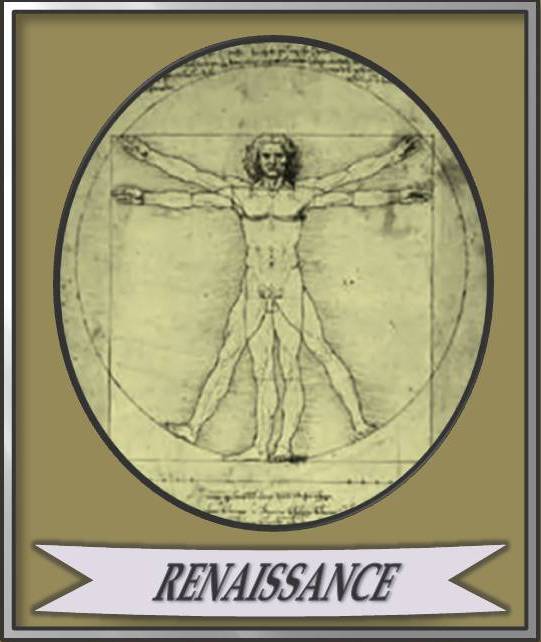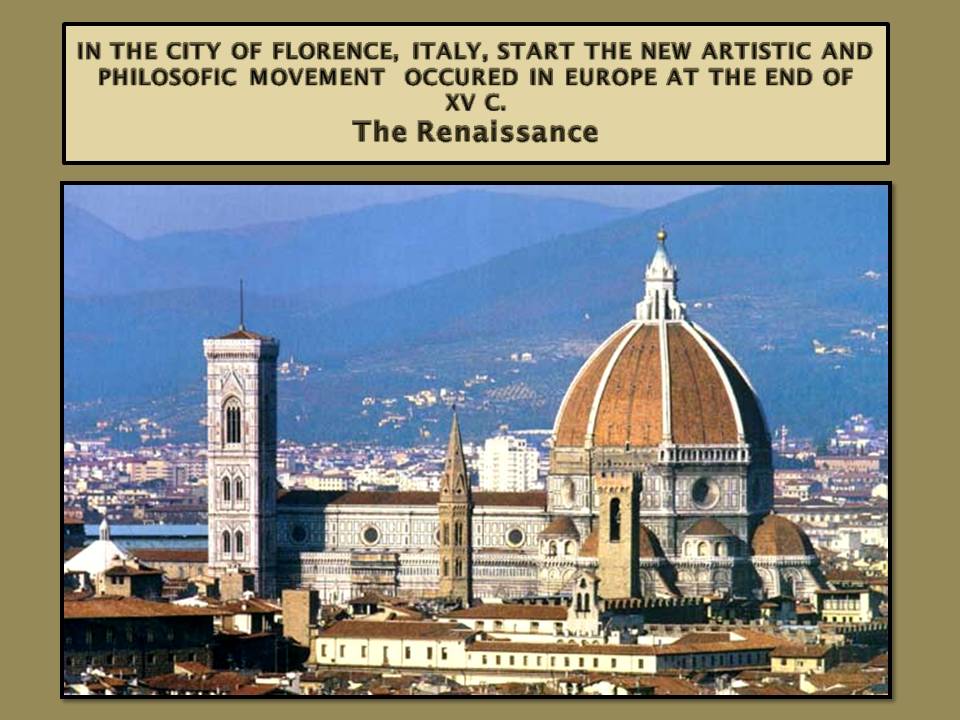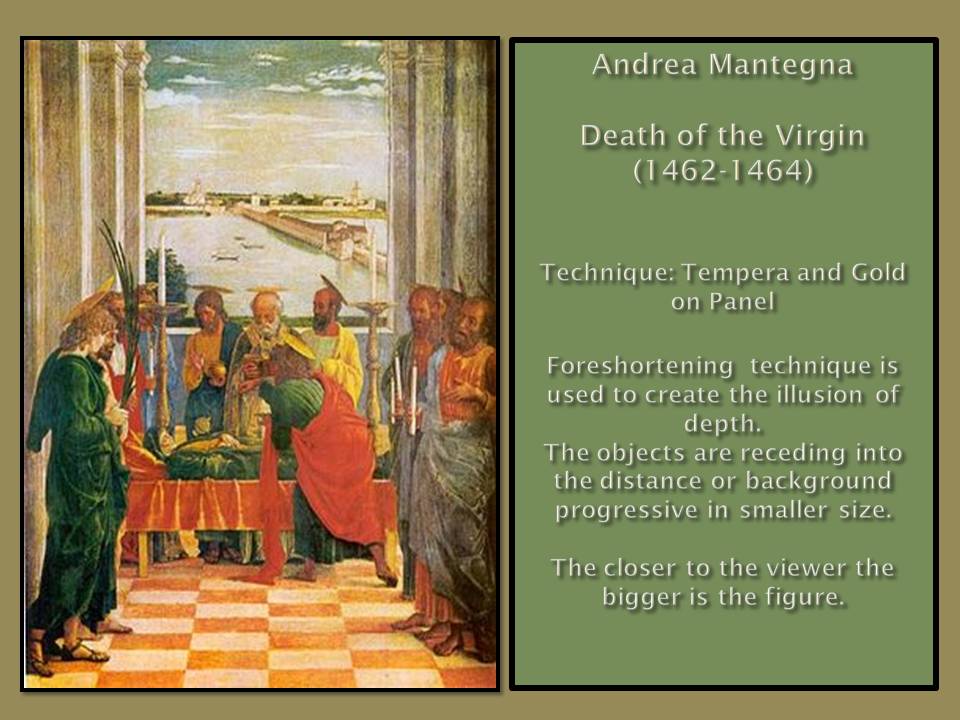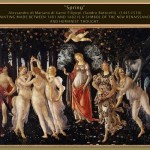The Renaissance
Is called Renaissance the great artistic and philosophical movement produced in Europe at the end of the 15th century which started in the city of Florence in Italy. This movement manifests itself particularly in the arts, admiring and taking as a model the classical antiquity and its anthropocentrism: (is given preferential interest to the human body, in particular to the naked, whose anatomy is studied and carefully copy).
The name of Renaissance alludes to what this movement wanted to be: a revival of Greco-Roman culture.
Humanism revitalization during Renaissance period
It began as a movement driven by artists and intellectuals, under the sign of humanism; in which for them the figure of man was paramount. It is an Arts revival in which from the point of view of ethical and aesthetic issues, the proposals represented are no longer absolutely according to the Christian concept of life.
The intellectuals of the Renaissance among other things, were inclined for the fusion of Christian belief with the knowledge of the ancient classical period of Greece and Rome, acting according to it, not oppose to Christianity, but towards been better Christians armed with the understanding of the work of ancient scholars. The philosopher Giovanni Pico de la Mirandola (1463-1494) in his “Prayer to the dignity of man” summarizes the humanism of the Renaissance and León Battista Alberti epitomizes in his multifaceted artistic and literary works the merits of the new man of the Renaissance with a big craving for learning.
Influenced by modern scientific advances like the study of medicine and philosophers works such as Cicero, the renaissance mans developed a particular optic, appreciating beauty through the nostalgia of the classical past. A taste for representing the anatomical realism of human body is developed, accompanied by its accurate graphic representation. The divine spirit of man, their emotions and their ability to communicate with his creator, are the source of main inspiration in the Renaissance, at the same time pondering the ability of man of been able to create innumerable practical and beautiful things and get the knowledge needed to be a better man and better Christian.
The Italian Cities States; first Florence, then also Venice and Milan, which had seen Greco-Roman culture been displaced from their regions during the middle ages, gradually evolve during the late Gothic period towards a rescue of the ancient traditional concept of beauty. For artists and philosophers of this period, it was necessary returning to the perfection of forms and circumvents what for them were nothing more than the Barbaric Gothic and Byzantine styles. Although naturally they don’t get freed immediately themselves from the Gothic influence that still had a lot of weight, both in the country as in the rest of the continent.
After the Dark Age and having survived the black plague, begins a period in which there is more appreciation for the individuality and the obtaining of knowledge through personal achievements, which for them were worth as much as gold. The Renaissance period marks the beginning of the modern era in the history of mankind.
A new cult of Fame from that moment arises and sculptural monuments and paintings are meant to enhance the figures importance and their achievements. No longer being rich marks the only way to belong to a high class, for that point onward is valued the individual as a creator and very appreciate what he is capable to brings to society in terms of knowledge and personal success.
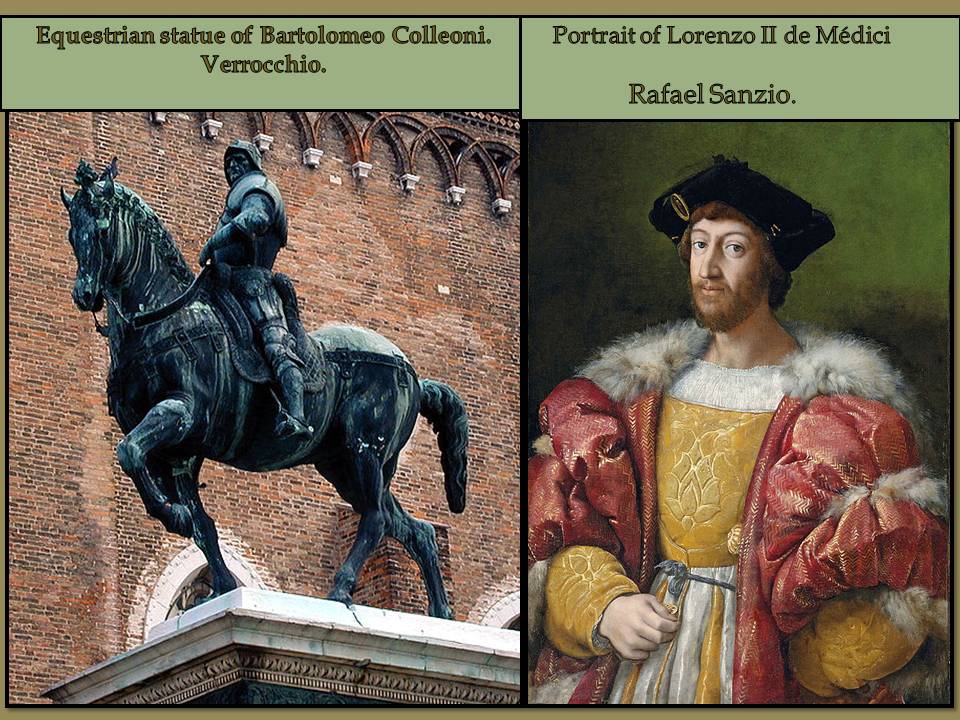
Artist during Renaissance period begin to be recognized as such.
Artists are respected and considered as important elements within the community and are released from the guilds of craftsmen. For them art was no longer an anonymous service to God and the Church. In the Renaissance the reason and knowledge were the artists personal hymn, praising the beauty, the proportion and harmony, both the nature and the image of the human being, for them essence of the sacred universal whole.
Already recognized as artist and not as mere anonymous craftsmen, they accept custom work petitions from private sector as well as from the clergy. They start signing their works openly during the Renaissance, which helps the history of art to recognize and classify their works from this point onwards more easily.
Main causes of the Renaissance emerge.
-It was possible to study the techniques and knowledge from ancient’s monuments and sculptures, thank to valuable manuscripts found in universities and medieval convents of Greek and Roman authors.
-The study and use of Latin as a cultured language, which made possible reading of the classics, as well as professional skill, contribute from the arrival of Greek exiles from the Turks invasion that were fleeing to Italy.
-The presence in Italian land of Roman ruins which gave rise to the desire to know the civilization that had set up magnificent monuments. (Such was the case of the artist Filipo Brunelleschi) who study the foundations and columns of those monuments.
-The invention of printing by the German Gutenberg, which contributed to the diffusion of the writings of poets, philosophers and historians in ancient times. The books mechanically printed made possible more people could have access to them.
– Geographical discoveries, the advancement of science, progress of scientific theories, (among of them Galileo’s centrist helium theory that revolutionized the scholar’s thinking).
– Development of several new techniques in diverse fields that paved the road towards innovative achievements in the XVI c.
GENERAL CHARACTERISTICS OF RENAISSANCE ART
– Imitation of architecture and sculpture of Greece and Rome.
– Realization of works with what for them was the ideal beauty, adjusted to canons dictated by reason.
– Search for the serenity and balance that comes from the harmony of the whole.
– They manage to capture the ideal way to correctly represent the aerial or linear perspective in painting, as well as the sensation of corporeality or three-dimensional figures.
– Applies the concept of spatial illusion in painting.
– Creation of equilibrate and harmonious works, whose clarity and perfection gives them a permanent validity.
– Expansion of themes in works such as mythology, religion, history, legends, portraits, landscapes, heroes etc.
– Conceptualization of the works that are endowed of a clever message with veiled codes.
– Application of the study of the divine proportion based on the human figure.
– Realistic representation of nature and the man.
– Use of expressive gesture reaching the highest intensity with the mannerisms.
– Figures are placed in complex formal arrangement.
– Use of chiaroscuro.
– Works of art in the Renaissance period tends to be monumental.
New painting techniques in the Renaissance
– The invention of linear perspective found by Filipo Brunelleschi in architecture and adapted by Masaccio in painting, marks a significant milestone in the possibility which the artist can represent and express the message, using scientific principles of optics that help the spatial display of scenes.
– With the increased use of the canvas as a base for paint opens new possibilities for the creation of new pigments on basis of oil; endowing the paintings of beautiful colors and sublime contrasts of light and shadow.
-The multitalented artist Leonardo Da Vinci (1452-1519) dominates the aerial perspective representing the atmosphere that wrap objects, blurring the convergent lines, eliminating the boundaries of shape and color, which gives a very real impression of distance. He constantly experimented with lacquers and adhesives but not all of them gave good results and for this reason his few works (many not totally finished) are not kept in good condition. Leonardo da Vinci achieved outstanding results with what is known as esfumato in which the tones of colors degrade to merge with each other imperceptibly, creating volume and depth. In his famous scheme of the Vitruvian man, shows a detailed study of the divine proportion based on the human figure, principle followed later by many other painters.
– The use of chiaroscuro in painting allows contrast of lights and shadows, giving dimension to a painting and the illusion of depth or three-dimensionality.
– The rediscovery of the mathematical proportions of the human body in the 15th century by Leonardo and other authors is considered one of the great achievements of the Renaissance.
– Foreshortening is a technique used by artists such as Andrea Mantegna in which to create the illusion of depth the objects receding strongly into the distance or background. The artist records, in varying degrees, the distortion that is seen by the eye when an object or figure is viewed at a distance or at an unusual angle. It makes parts of an object or subject closest to you appear much larger relative to other parts or figures. The closer to the viewer the bigger is the figure.
| Death of the Virgin | Author:Andrea Mantegna (1431-1506) |
| It makes parts of an object or subject closest to you appear much larger relative to other parts or figures. The closer to the viewer the bigger is the figure. | painted in (1462–1464) |
| Foreshortening technique | Technique: Tempera and gold on panel |
In the next article will be summarize the Renaissance in art seen according to its division for periods of time.
The Trecento, the Quatrocento and the Cinquecento.

